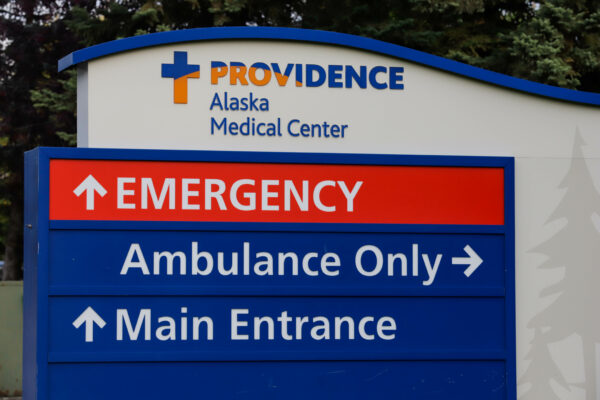
After a large spike in COVID-19 cases earlier this year that strained hospital resources, Anchorage hospital officials are cautiously hopeful that a return to more normal conditions is near.
In late January, Alaska saw more than 14,000 cases of COVID-19 in one week, a record driven by the omicron variant. Its high transmission rate was hitting hospital staff hard.
“Throughout January and most of February, their facilities were dealing with a lot of staff out,” said Jeannie Monk, senior vice president of the Alaska State Hospitals and Nursing Home Association.
While omicron sent a lot of people to the hospital, fewer of them needed intensive care and ventilation than during the delta spike, Monk said.
“But at the same time, hospitals have been very busy because throughout delta and this whole pandemic, many people have postponed care, and now are at the point where they need it,” Monk said. “The care that they had postponed was becoming more and more urgent.”
Case counts across the state have plunged since the winter omicron spike. COVID hospitalizations have dropped by more than half since the end of January. They’re less than a quarter of what they were at last year’s peak.
Providence Alaska Chief Medical Officer Dr. Michael Bernstein said omicron’s impact on hospitals was not nearly as bad as delta’s, for a couple reasons. One is that more people are vaccinated, so their infections are less severe. And omicron itself is helping to lessen the strain on hospitals, due — ironically — to its prolific spread and how it’s transmitted.
READ MORE: Alaska’s largest hospital now rationing care due to COVID surge
“Omicron just happens to be better at the mechanism that’s more efficient in the nose and much less efficient at affecting the one in the lungs,” Bernstein said. “So that combination really was kind of a gift to us because it meant it spread through huge amounts of the population, increasing the amount of people that are immune. But it didn’t overwhelm us more than delta.”
Bernstein clarified that vaccination provides much more immunity than omicron infection does.
Dr. Robert Onders, administrator of the Alaska Native Medical Center, noted that most of the patients that the hospital saw during the Omicron surge were not vaccinated.
“We still have a fairly large segment of the population that is unvaccinated, particularly in the urban areas,” Onders said.
READ MORE: As COVID numbers drop, state health officials continue to urge vaccination
While case counts and hospitalizations are lower, Monk, with the hospital association, says data may not tell the whole story.
“We’re not doing the level of testing that we were, and people are relying on home tests,” Monk said. “And so we can’t rely on case counts anymore to tell us what’s going on.”
All three health care officials say a new variant of COVID could renew the need to exercise more caution. For now, they recommend people stay up to date on vaccinations and wear masks in indoor public places, but they’re hopeful that COVID will become more of an illness, like the flu, that does not overwhelm hospital capacity.
[Sign up for Alaska Public Media’s daily newsletter to get our top stories delivered to your inbox.]
Wesley Early covers Anchorage life and city politics for Alaska Public Media. Reach him at wearly@alaskapublic.org and follow him on X at @wesley_early. Read more about Wesley here.





